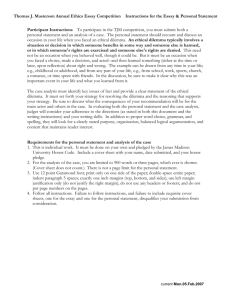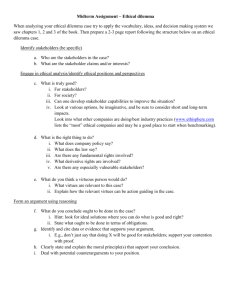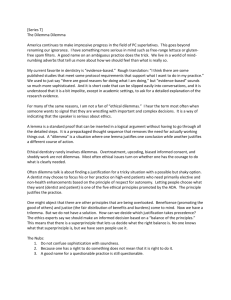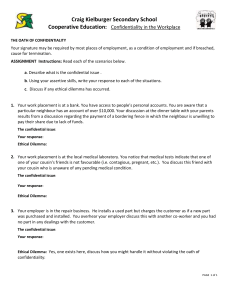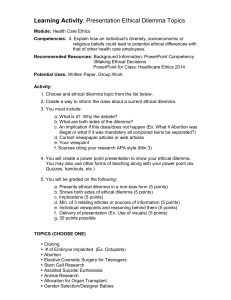homeec3_3A_dec12.doc
advertisement
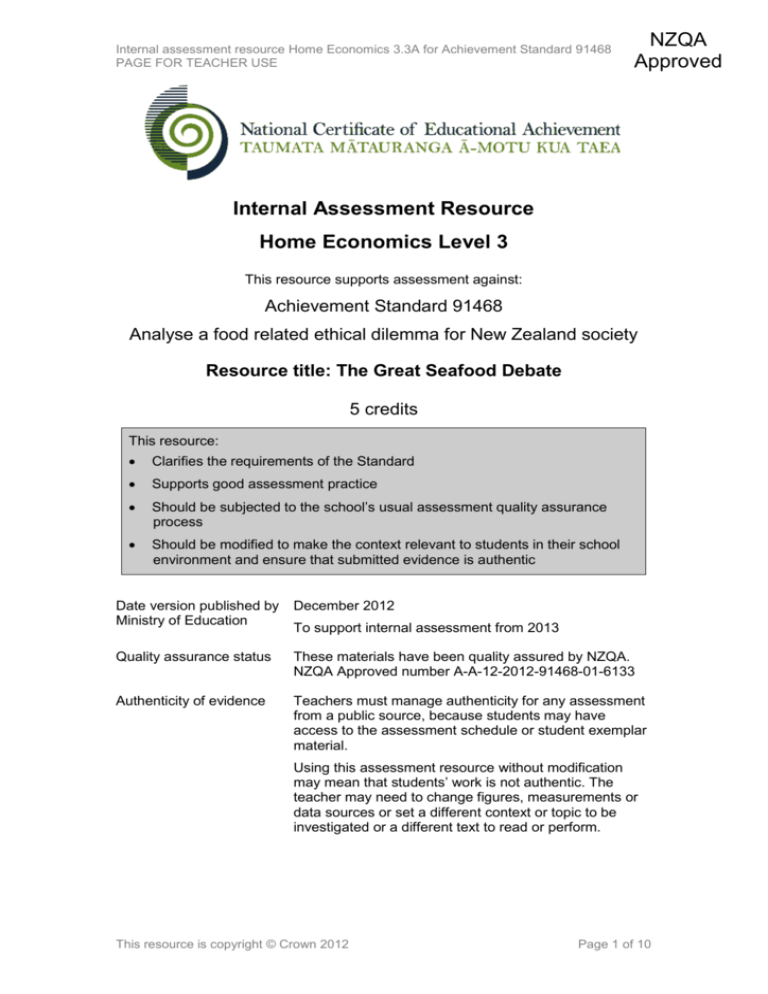
Internal assessment resource Home Economics 3.3A for Achievement Standard 91468 PAGE FOR TEACHER USE NZQA Approved Internal Assessment Resource Home Economics Level 3 This resource supports assessment against: Achievement Standard 91468 Analyse a food related ethical dilemma for New Zealand society Resource title: The Great Seafood Debate 5 credits This resource: Clarifies the requirements of the Standard Supports good assessment practice Should be subjected to the school’s usual assessment quality assurance process Should be modified to make the context relevant to students in their school environment and ensure that submitted evidence is authentic Date version published by Ministry of Education December 2012 Quality assurance status These materials have been quality assured by NZQA. NZQA Approved number A-A-12-2012-91468-01-6133 Authenticity of evidence Teachers must manage authenticity for any assessment from a public source, because students may have access to the assessment schedule or student exemplar material. To support internal assessment from 2013 Using this assessment resource without modification may mean that students’ work is not authentic. The teacher may need to change figures, measurements or data sources or set a different context or topic to be investigated or a different text to read or perform. This resource is copyright © Crown 2012 Page 1 of 10 Internal assessment resource Home Economics 3.3A for Achievement Standard 91468 PAGE FOR TEACHER USE Internal Assessment Resource Achievement Standard Home Economics 91468: Analyse a food related ethical dilemma for New Zealand society Resource reference: Home Economics 3.3A Resource title: The Great Seafood Debate Credits: 5 Teacher guidelines The following guidelines are supplied to enable teachers to carry out valid and consistent assessment using this internal assessment resource. Teachers need to be very familiar with the outcome being assessed by Achievement Standard Home Economics 91468. The achievement criteria and the explanatory notes contain information, definitions, and requirements that are crucial when interpreting the standard and assessing students against it. Context/setting This assessment activity requires students to analyse a food related ethical dilemma for New Zealand society. The given context is sustainable fishing practices in New Zealand but the resource could easily be adapted for another context. The Achievement Standard suggests a variety of possibilities. The students should negotiate with you a suitable format for their report or presentation. Conditions This is an individual assessment activity, but students may explore different viewpoints and undertake initial research as a class or in a group. It is suggested that 50 hours of in-class and out-of-class time be allocated to the teaching, learning, and assessment associated with this Achievement Standard. Resource requirements books, reports, magazines, websites, and other reputable sources of information Internet and library access software and hardware for report presentation. It may also be useful for students to be given a list of ethical principles/approaches. See: http://www.scu.edu/ethics/practicing/decision/approach.html or http://www.scu.edu/ethics/practicing/decision/thinking.html Useful resources for researching sustainable fishing practices in New Zealand could include but are not limited to: Marine Stewardship Council: www.msc.org Ministry of Fisheries: www.mfish.govt.nz National Institute of Water and Atmospheric Research: www.niwa.cri.nz This resource is copyright © Crown 2012 Page 2 of 10 Internal assessment resource Home Economics 3.3A for Achievement Standard 91468 PAGE FOR TEACHER USE Royal Forest and Bird Protection Society: www.forestandbird.org.nz Seafood Industry Council: www.seafood.co.nz Sustainable Fisheries NZ Consumer: www.consumer.org.nz › Food New Zealand Sport Fishing Council: www.nzsportfishing.co.nz/ World Wildlife Fund New Zealand: www.wwf.org.nz/what_we_do/marine/sustainable_fisheries/ Additional information Group discussions are a good way to introduce students to an ethical issue by drawing attention to a wider range of viewpoints than they may have come up with individually. See Resource 3 for suggested discussion frameworks. This resource is copyright © Crown 2012 Page 3 of 10 Internal assessment resource Home Economics 3.3A for Achievement Standard 91468 PAGE FOR STUDENT USE Internal Assessment Resource Achievement Standard Home Economics 91468: Analyse a food related ethical dilemma for New Zealand society Resource reference: Home Economics 3.3A Resource title: The Great Seafood Debate Credits: 5 Achievement Analyse a food related ethical dilemma for New Zealand society. Achievement with Merit Analyse, in depth, a food related ethical dilemma for New Zealand society. Achievement with Excellence Analyse comprehensively a food related ethical dilemma for New Zealand society. Student instructions Introduction A dilemma asks you to choose between two alternatives. These alternatives may be equally undesirable. This assessment activity requires you to analyse the ethical dilemma that having access to unlimited seafood poses for New Zealand society. (A food related ethical dilemma is one that challenges beliefs, values, and practices related to foods.) Teacher note: With minimal changes, this assessment resource could be adapted for a variety of other food related ethical dilemmas, for example, factory farming (of chickens or pigs), fluoridation of water supplies, fast foods, industrial scale dairy farming, food sovereignty. This will involve: working as a class or in a group to define and explore the dilemma and then to identify and explore a range of contrasting viewpoints on the issue either individually or in a group, analysing these viewpoints individually creating a report or presentation in which you set out your analysis of this dilemma. Negotiate a suitable format for your report or presentation with your teacher. Teacher note: Allow students to select a suitable format. This could be, for example, an essay, written report, magazine-style article, slide presentation, podcast, or a video presentation in the style of an investigative news report. You will have <<teacher to insert time and conditions here>> hours of in-class and out-of-class time to complete this assessment activity. Teacher note: Adapt the time allowed as necessary to meet the needs of your students. You will be assessed on the depth and comprehensiveness of your analysis. This resource is copyright © Crown 2012 Page 4 of 10 Internal assessment resource Home Economics 3.3A for Achievement Standard 91468 PAGE FOR STUDENT USE Task As a class or in a group, further define the nature of the seafood dilemma. What makes it a dilemma instead of just an issue? Why is it of public concern, why it poses ethical questions, and why it is of relevance to New Zealanders? Brainstorm a list of those who have an interest in the outcome of this dilemma (i.e. the stakeholders). Explore a variety of different stakeholders’ viewpoints on the dilemma. With the help of your teacher, identify reports, websites, and other sources of credible information, as well as organisations and individuals you might approach for information and viewpoints. Research your selected food related ethical dilemma. See Resource 1 for a sample workflow. Keep your own detailed notes of ideas, information (including sources), and findings. Resource 2 suggests questions that may help you. Review your notes to ensure you have enough evidence to enable you to write a report or presentation of sufficient depth. Create your report or presentation Individually create a report or presentation in which you analyse the seafood dilemma in terms of its implications for New Zealand society. Define and explain the nature of this dilemma. Identify a range of people/groups who have an interest in the outcome of this dilemma. Explain the implications of this dilemma for the well-being of New Zealand society. Describe and explain a range of contrasting viewpoints (support or oppose) on the issue, relating these to the different stakeholders. Explore the underlying beliefs, values, and practices that are associated with the contrasting viewpoints. (You may wish to link these contrasting viewpoints to relevant ethical principles such as the rights approach, the utilitarian approach, the fairness (justice) approach, the common good approach, or the virtue approach.) Explain how those underlying beliefs, values, and practices influence people’s viewpoints on the issue. Critically evaluate the viewpoints of the different stakeholders you have identified. Outline some possible consequences and challenges of this dilemma for New Zealand society. Consider those directly affected by the issue (personal wellbeing, human rights), others associated with those people (family, whānau wellbeing), and wider society (societal well-being, environment, Government policy, Treaty of Waitangi, employment). Provide detailed examples and supporting evidence where possible. Cite all sources so that a reader could look them up. Submit your report or presentation, as agreed with your teacher. This resource is copyright © Crown 2012 Page 5 of 10 Internal assessment resource Home Economics 3.3A for Achievement Standard 91468 PAGE FOR STUDENT USE Resource 1: Sample workflow for researching an ethical dilemma The following sample workflow is a guide to researching an ethical dilemma, using sustainable seafood as an example. There are other ways to approach the research process. Find a way that suits you. 1. Define the ethical dilemma you are analysing. In the case of the great seafood debate, for example, what is it about the subject that makes it a dilemma and why is the dilemma an ethical one? 2. Determine a range of stakeholder viewpoints relative to this dilemma. Between the two directly opposing points of view, there may be a continuum of viewpoints. 3. Formulate a set of questions that will guide your research into and analysis of different viewpoints. For example, you could ask: Which group or groups of stakeholders are of this view? What practices do they engage in that might have contributed to their thinking? What factual evidence is there to support or justify this viewpoint? What beliefs and values underlie this viewpoint? What ethical principles such as the rights approach, the utilitarian approach, the fairness (justice) approach, the common good approach, or the virtue approach are connected to this viewpoint? What are the possible consequences of this viewpoint? 4. Gather information and examples that could help you answer your questions. This might come from government websites, academic reports, newspaper articles, and press releases by non-government organisations, or interviews you conduct yourself. 5. Critically examine and interpret this information. Is it relevant? Is it too trivial or too general to be useful? Is it fact or opinion? Whose opinion is it? Is it accurate? Can I test its accuracy or confirm it from another source? Was this information gathered fairly? Is it presented fairly? Does it reflect the objectives/agenda of a particular organisation or person? What are my attitudes to this information? What assumptions do I have about this issue? How are these influencing my interpretation of this information? 6. Formulate answers to your questions. 7. Consider whether there are now new questions you’d like to answer. This resource is copyright © Crown 2012 Page 6 of 10 Internal assessment resource Home Economics 3.3A for Achievement Standard 91468 PAGE FOR STUDENT USE Resource 2: Possible questions for exploring viewpoints The following questions can provide a starting point for exploring a range of contrasting viewpoints associated with a food-related ethical dilemma. The goal is to generate ideas for further investigation. Who has a financial/economic stake in this dilemma? Who has a non-financial/non-economic stake in this dilemma? What other stakes (for example, ethical, ecological, cultural, scientific, social justice) do people have in this dilemma? How do different stakeholders regard the dilemma? What evidence might they point to, in order to support their viewpoints? What beliefs and values might they hold? How do the viewpoints of stakeholders influence their practices? Depending on which way the dilemma is resolved, what might be the consequences for New Zealand society? Who might be advantaged or disadvantaged by the outcome? How might we influence or challenge the outcome of this dilemma? What evidence could we put forward to support our position? Resource 3: Suggested discussion frameworks Group discussions may help students to access and explore different points of view prior to analysing these more thoroughly. The following two frameworks may be useful. Discussion webs This approach is based on the discussion web process proposed by D.E. Alvermann in her article "The Discussion Web: A Graphic Aid for Learning Across the Curriculum" in The Reading Teacher, October 1991. Pose the ethical dilemma as a yes/no question. For example: Should New Zealanders have access to unlimited seafood as we are an island nation? OR Should large fishing companies be restricted to quotas on certain fish or quotas on overall catches? 1. Provide a brief introduction to the issue or require students to briefly research it. Show students a TV news item you find online, share a report from a newspaper, or print an article or information sheet from a group such as Greenpeace or the World wildlife fund, or a government department. Students could then explain briefly why this is an ethical issue. 2. Students work in pairs to brainstorm reasons for “yes” and for “no”. They may include opinions, facts, personal experiences, and evidence that will need clarifying through further research. (Possible questions to explore: Who holds this perspective/viewpoint? What do they believe? Why do they believe this? What are the implications of this perspective for people directly affected, others associated with those people, and wider society?). 3. Each pair of students pairs up with another two-person team to compare and combine their lists. This resource is copyright © Crown 2012 Page 7 of 10 Internal assessment resource Home Economics 3.3A for Achievement Standard 91468 PAGE FOR STUDENT USE 4. Teams continue to combine until the class comes together with a range of viewpoints and a list of evidence and ideas to be further investigated. Similar group discussions can be conducted to explore different aspects of the dilemma. The goal is to formulate questions as a guide to further research. Alternatively, the class can brainstorm a list of stakeholders and student pairs could each consider the viewpoint of a different stakeholder group before reporting back to the class. In this case, they could look at the stakeholders’ underlying beliefs and values and the practices that have contributed to their viewpoints. Four corners debate Once your class has come up with a range of viewpoints on an ethical issue, a four corners debate can help them acknowledge their own opinion while deepening the discussion about these different points of view. 1. Select two or more of the identified viewpoints to illustrate the range of possible opinions on the issue (see the examples below). 2. Assign each viewpoint to a particular corner or area of the classroom. 3. Students decide (maybe write down) which viewpoint best matches their own. 4. Students move to their designated area and work with others who share their opinion to gather viewpoints and evidence. 5. Each group reports back to the class. 6. Students consider whether they have changed their opinion in any way. For example: Should New Zealanders have access to unlimited seafood as we are an island nation? People should be able to gather food such as seafood from their local beaches, sea and rivers to feed their families. As tourism is a large income earner, New Zealand’s fishing resources should be managed to ensure sufficient fish for the future. If you make the effort to go and collect seafood you should be allowed as much as you like. New Zealanders should have the right to harvest and sell seafood as a way of earning a living. This resource is copyright © Crown 2012 Page 8 of 10 Internal assessment resource Home Economics 3.3A for Achievement Standard 91468 PAGE FOR TEACHER USE Assessment schedule: Home Economics 91468 GM or no GM? Evidence/Judgements for Achievement Evidence/Judgements for Achievement with Merit Evidence/Judgements for Achievement with Excellence The student has analysed a food related ethical dilemma (in this case, the seafood debate), presenting their analysis in the form of a report or presentation. In it, the student has: The student has analysed, in-depth, a food related ethical dilemma (in this case, the seafood debate), presenting their analysis in the form of a report or presentation. In it, the student has: The student has comprehensively analysed a food related ethical dilemma (in this case, the seafood debate), presenting their analysis in the form of a report or presentation. In it, the student has: explained the nature of the ethical dilemma and the contrasting viewpoints associated with it explained the nature of the ethical dilemma and the contrasting viewpoints associated with it explained the nature of the ethical dilemma and the contrasting viewpoints associated with it explained how the ethical dilemma may affect New Zealand society. explained how the ethical dilemma may affect New Zealand society explained how the ethical dilemma may affect New Zealand society explored the underlying beliefs, values, and practices associated with those holding contrasting viewpoints explored the underlying beliefs, values, and practices associated with those holding contrasting viewpoints explained how the underlying beliefs, values, and practices influence viewpoints relating to the ethical dilemma. explained how the underlying beliefs, values, and practices influence viewpoints relating to the ethical dilemma critically evaluated the viewpoints of different stakeholders and outlined some possible consequences and challenges for New Zealand society. For example: Fish and seafood is an important part of New Zealand’s food heritage. Many people believe that it is every New Zealander’s right to be able to catch and eat seafood. This raises people’s awareness of the importance of protecting fish stocks. Some New Zealanders are conscious consumers who try to choose fish responsibly. Greenpeace publishes a Red List of fish that it says are probably sourced from unsustainable fisheries. It includes popular species such as orange roughy, hoki, hake, shark, and tuna, as well as shrimp. Many people, however, do not have a personal connection with the sea and do not care where the fish they buy comes from. There is an assumption that the sea is vast and teeming with life. Recreational fishermen and divers often have unique insight into the state of our marine ecosystems, gained over many years of observation. Some of these believe that marine reserves are not a good way to protect the oceans. This resource is copyright © Crown 2012 For example: Although a minority, a lot of New Zealanders think of themselves as “green”. Being green can involve anything from occasional attempts to minimise waste to restoration planting of degraded land to engaging in continuous lobbying on environmental issues. Sustainable fishing is a very important issue for many greens, who support the establishment of global marine reserves as a way ‘to protect our seas from the ravages of climate change, to restore the health of fish stocks, and to protect ocean life from habitat destruction and collapse.’ Greens are often motivated by what could be called spiritual values, but what this means varies greatly from person to person. For some, the Earth For example: On the other hand, New Zealand’s marine reserves – areas that are completely protected from exploitation – comprise only 0.3% of our total marine environment. According to Forest & Bird, New Zealand’s largest independent conservation organization, international scientists believe that at least 20% of marine areas should be protected as reserves. It wants New Zealand to protect 30% of its marine environment by 2030. Providing this protection could have unintended consequences. For example, if we prevent people Page 9 of 10 Internal assessment resource Home Economics 3.3A for Achievement Standard 91468 PAGE FOR TEACHER USE They claim that pollution from the land is the main threat to sea life and that this should be a focus of conservation efforts. Many New Zealanders are proud that our nation’s seafood resource is effectively managed. New Zealand uses a Quota Management System (QMS) that is internationally regarded as one of the world’s best fisheries management systems. The World Bank has praised New Zealand’s QMS and absence of subsidies as an example of how other countries should manage their fisheries. The examples above relate to only part of what is required, and are just indicative. and everything in it is God’s creation and we should not be trying to take over His role. For others, all life is sacred and everything interconnected, so we have no right to be interfering with plant or animal DNA and if we do, we invite catastrophe. Many Māori, though not necessarily identifying with the “green” label, have similar views, attributing to every living thing a whakapapa that goes back ultimately to Rangi and Papa. For some Greens, their viewpoint is based more on pragmatic considerations: for example, they can see how the Earth has already been damaged by human activity (for example, by pollution) and they want to limit further damage. Or they are motivated by the desire to leave a viable planet for their children and their children’s children. Greens also tend to be suspicious of the behaviour of large multinational companies, whom they accuse of putting profits before people, crushing competitors (including very small ones), harming biodiversity, and not being answerable for their actions. from fishing or harvesting seafood from some areas, it seems sensible to expect them to exercise their rights to fish elsewhere. This could perhaps concentrate fishing in a few accessible locations, making them more vulnerable to overfishing. The government has introduced quotas or restrictions for specific species to try and ensure everyone has access to fishing and catching their own fresh fish. Furthermore, many of the commercially fished species are migratory and range across large distances. Writing in the research magazine Oceanus, US scientists report that satellite tracking shows large trawlers clustering around the borders of closed areas of Georges Bank in the Gulf of Maine, the protected breeding ground of many fish species. Equipped with advanced technology, these ships can locate and take any fish that stray over the boundaries of the marine reserve. The examples above relate to only part of what is required, and are just indicative. The examples above relate to only part of what is required, and are just indicative. Final grades will be decided using professional judgement based on a holistic examination of the evidence provided against the criteria in the Achievement Standard. This resource is copyright © Crown 2012 Page 10 of 10

